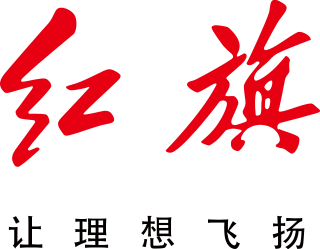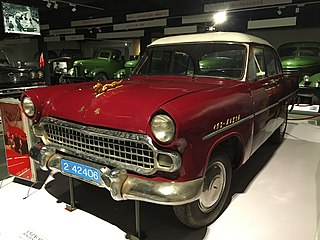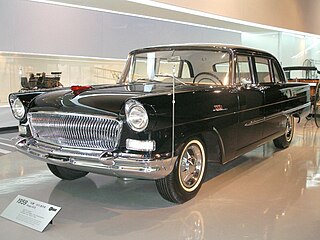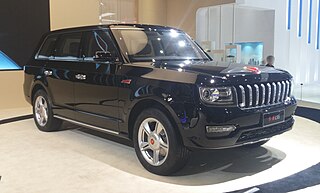
CarlFriedrich Benz was a German engine designer and automotive engineer. His Benz Patent-Motorwagen from 1885 is considered the first practical modern automobile and first car put into series production. He received a patent for the motorcar in 1886, the same year he first publicly drove the Benz Patent-Motorwagen.

Citroën is a French automobile brand. The "Automobiles Citroën" manufacturing company was founded in 4 June 1919 by André Citroën. Citroën has been owned by Stellantis since 2021 and previously was part of the PSA Group after Peugeot acquired 89.95% share in 1976. Citroën's head office is located in the Stellantis Poissy Plant in Saint-Ouen-sur-Seine since 2021 and its offices studies and research in Vélizy-Villacoublay, Poissy (CEMR), Carrières-sous-Poissy and Sochaux-Montbéliard.

The automotive industry comprises a wide range of companies and organizations involved in the design, development, manufacturing, marketing, selling, repairing, and modification of motor vehicles. It is one of the world's largest industries by revenue.

The Shanghai SH760 is a car produced in China from 1965 to 1991 primarily for government officials not important enough to warrant a FAW Hongqi and as a taxi. The design was based on the Mercedes-Benz 220S (W180) from 1954, with modified front and rear styling to resemble an American Packard of the same era such as the Patrician 1955 model.

The Benz Patent-Motorwagen, built in 1885 by the German Karl Benz, is widely regarded as the first practical modern automobile and was the first car put into production. It was patented in January 1886 and unveiled in public later that year. The original cost of the vehicle was 600 imperial German marks, approximately 150 US dollars.

China (Guangzhou) International Automobile Exhibition, also called Guangzhou International Motor Show or Auto Guangzhou, is an auto show held by Guangzhou Zhanlian Exhibition Service Co., Ltd, in November and December every year in the Guangzhou International Convention and Exhibition Center, China. It is not a recognized international show by the Organisation Internationale des Constructeurs d'Automobiles.
Beijing International Automotive Exhibition, Beijing Motor Show or Auto China is an auto show held biennially in Beijing, China since 1990. China is currently the largest auto market in the world.

A car, or an automobile, is a motor vehicle with wheels. Most definitions of cars state that they run primarily on roads, seat one to eight people, have four wheels, and mainly transport people over cargo. There are around one billion cars in use worldwide. The car is considered an essential part of the developed economy.

Auto Shanghai, officially known as the Shanghai International Automobile Industry Exhibition, is a biennial international automobile show that alternates with the Beijing Auto Show as China's yearly international automotive exhibition. First held in 1985, Auto Shanghai is the nation's oldest auto exhibition, and is considered as an important major international auto show.

Hongqi is a Chinese luxury car brand operated owned by the automaker FAW Group. Hongqi was launched in 1958, making it the oldest Chinese passenger car brand. In Chinese, hongqi means "red flag."

California Automobile Museum is an automobile museum located in Sacramento, California. It has a collection of over 150 classic cars, race cars, muscle cars and early models displayed throughout 72,000 square feet (6,700 m2) of museum space. The mission of the California Automobile Museum is to preserve, exhibit, and teach the story of the automobile and its influence on our lives.

Beijing Automotive Group Co., Ltd. is a Chinese state-owned automobile manufacturer headquartered in Shunyi, Beijing. Founded in 1958, it is the sixth largest automobile manufacturer in China, with 1.723 million sales in 2021.

Venucia is a car marque of Dongfeng Nissan Passenger Vehicle Company, a subsidiary of Dongfeng Motor Co., Ltd. The marque was launched in September 2010 by Dongfeng Nissan. From February 2017 until the end of 2020, Venucia was spun off from Dongfeng Nissan as a separate Dongfeng Motor Co., Ltd. subsidiary focused on the marketing and production of cars, with the name Dongfeng Venucia Motor Company. In December 2020, Dongfeng Motor Co., Ltd announced it would merge Venucia back into Dongfeng Nissan.

The Dongfeng CA71 is a medium-size luxury car made by the Chinese automobile manufacturer First Automotive Works (FAW) and produced in small numbers in 1958. It was the first passenger car to be produced entirely in China.

The Aeolus S30 or previously the Dongfeng Fengshen S30 is a subcompact sedan produced by Dongfeng Motor Corporation under the Aeolus sub-brand from 2009 to 2017. The 5-door hatchback version was called Aeolus H30.

The Hongqi CA72 is an automobile produced by FAW Hongqi. It was the company's first production automobile and the first representative sedan that was constructed and built in China. Produced from 1959 until 1965, the CA72 was only available to state institutions and the leadership of the Chinese Communist Party and was regularly used in public events until the 1970s. Numerous details about technology and production are unclear.

The Hongqi LS5 is a full-size luxury SUV that was manufactured by Chinese automobile manufacturer Hongqi, a subsidiary of FAW Group, from 2015 to 2017 for use by the Chinese Government only.

The Dongfanghong BJ760 is an executive sedan produced by BAW. Development started as a licensed copy of the GAZ-21 Volga with assistance from the Soviets sharing chassis units, drawings and blueprints for reference, and was produced from 1960 to 1969 with a total of 238 units produced. It replaced the Jinggangshan sedan by BAW. During development, the car was named Xinghuo 76, but was later changed to Dongfanghong for the production version. The name Dongfanghong means "The East is Red" and refers to a patriotic song of the Chinese Communist Party. The name has been used by multiple companies for branding and product names.
There are currently about 150 active brands in the Chinese automobile market. Among them are 97 Chinese domestic brands and 43 joint venture (JV) brands. Before 2010, the traditional "Big Four" refers to the four major state-owned car manufacturers, SAIC, FAW, Dongfeng and Changan. Other Chinese car manufacturers, both from public and private sectors, like Geely, BAIC, BYD, Chery, GAC, Great Wall, JAC and Seres emerged as the major players with the expansion of Chinese automotive industry.

























